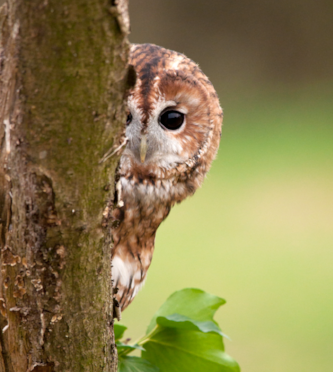
Tawny Owl. Photo: Howard Stockdale BTO
Twenty minutes once during your week is all it will take to find out just how Britain’s Tawny Owls are faring.
The British Trust for Ornithology (BTO) is asking members of the public to listen out for Tawny Owls to help build a picture of what is happening to our most widespread owl.
Evidence suggests that our Tawny Owl population is falling and it might be that we are losing them from our towns and cities. Taking part in the BTO’s Tawny Owl Calling Survey will help make this clearer.
Tawny Owls are very difficult to monitor, as they live their lives during the hours of darkness, so we often hear them rather than see them. We want people to listen for the distinctive ‘hoot’ calls of the males and sharp ‘kee-wick’ of the females. Anyone can take part and the BTO website has a series of Tawny Owl recordings for people to familiarize themselves with the various calls.
Claire Boothby, Tawny Owl Calling Survey Organiser at the BTO, said, ‘Getting involved couldn’t be simpler – Just wrap up warm and give yourself 20 minutes to listen for the haunting calls of Tawny Owls between now and the end of March. You can listen from your garden, local wood or park, or even from the comfort of the sofa with your window open, and tell us whether or not you hear an owl. Don’t worry if you don’t hear one in your 20 minutes; that record is just as valuable and you’ll become one of our Zero Heroes!’.
The BTO would like at least 10,000 people across the UK to take part, nearly 6000 volunteers have already told what us what they have heard, you can help by listening out too.
Please visit www.bto.org/owls for more information.
ENDS
[registration_form]
‘Zero Hero’ — clever tag.
A great survey.
Out beating today, it struck me that I rarely see a Tawny flushed from cover, compared to say thirty years ago. The woods have grown , (maybe birds were disturbed more easily from smaller trees),but
many have been replanted, and are at the thicket stage again, so not much change there.
Neither is it so common to hear the rabble of smaller birds, discovering an owl at daytime roost, at least I don’t think so.
Maybe the Goshawks have killed them all.
Trapit – I don’t believe I see as many Tawny Owls as I used to either – but such memories are. of course, unreliable. It would have to be a pretty active and itinerant Gosghawk population to have removed Tawny Owls from my area. Since Kestrels have declined too, maybe it’s a loss ov voles in the countryside. And no, they haven’t been hoovered up by the vast flocks of Hen Harriers that are such a pest these days. 😉
Trapit: yes, the raucous rabble rousing of mobbing birds at an owl roost is very rarely heard theses days cf. to 30 years ago.